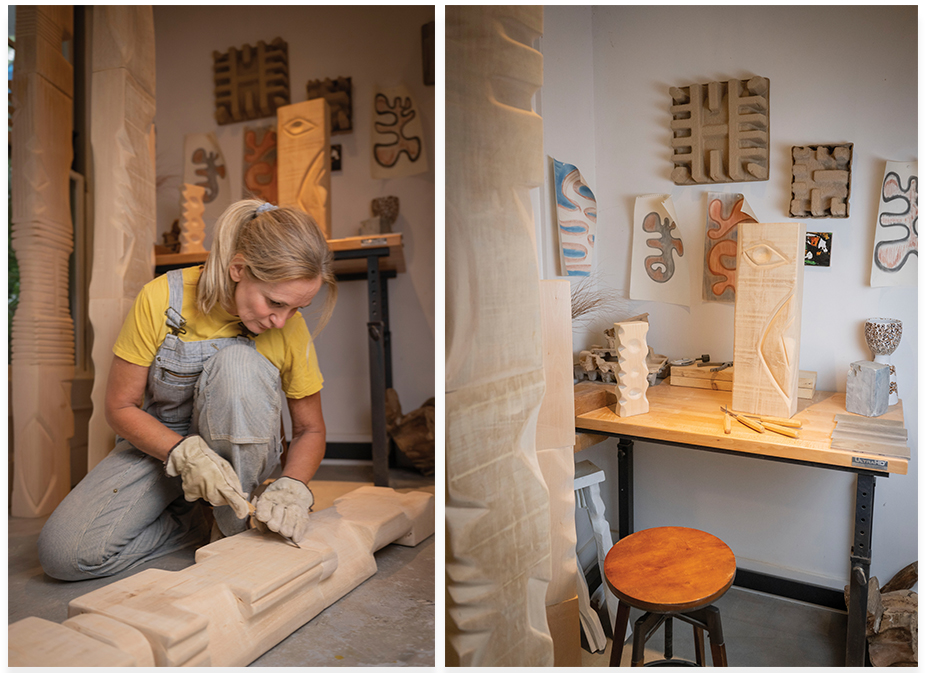
While at home during COVID, abstract painter Nathalie Naylor discovered she loved sculpting wood, finding the smell and the noise therapeutic. Her totems are inspired by the landscape of Corsica, where the artist spent summers with her family as a child.
After French-born Nathalie Naylor moved from New York to Charleston in the mid-1990s, she made a name for herself as an interior stylist and abstract painter. But during the pandemic, the self-taught artist—who grew up in France’s Loire Valley and studied art history at Ècole des Métiers de la Culture et du Marché de l’Art in Paris—says she had recurring dreams about sculpting wood.
With nothing else to do, she began to experiment. The results are smooth linden-wood totems that register much the same as megalithic statues found in nearly every culture in history. Eventually, Naylor realized how her decades of summers spent visiting family on the Mediterranean island of Corsica—its rugged, windblown terrain, prehistoric menhirs (tall upright stones) and dolmens (megalithic portals)— and her connection to her ancestors were influencing her work. Here, she shares her creative process and the ties she’s discovered along the way.
Art Foundation: I worked at different galleries in Paris and in New York. I quickly realized I’m not a merchant. I hated it, so I went home at night and painted. I was living in New York and painting in a tiny apartment. Then my husband and I moved to Charleston in 1995, and I had more room, but I also had a baby, and 14 months later, I had another baby. It was harder to paint, but I kept going in my own rhythm. I’ve never been good at self-promotion, but people began to buy my work by word of mouth.
Shaping Up: I’m self-taught, and I don’t know how to draw, so I’m very limited in shapes. Sometimes limits are good, though. When you study all the masters and all the techniques, you can be overwhelmed. It’s very hard to find your own voice, but when you do it on your own without the influence of teachers or classmates, it may be limited, but it’s very personal. I’ve always been interested in raw art made by people with no formal art background.

Naylor says her creative process is spontaneous. She finds a flow and keeps going.
On Experimenting: I moved during COVID, and we were renting a house, so I wasn’t painting because I didn’t want to make a mess. COVID was a strange time—nobody knew what was going to happen next. I had been thinking about carving wood and thought, ‘It’s now or never,’ so I ordered a piece of wood and a little chisel and just started. I loved it. I love the smell and the noise the chisel makes. It’s so therapeutic I could spend all day doing it. It’s a miracle I still have my fingers, though!
Creative Process: I just start and keep going; it’s really spontaneous. I like my sculptures to be smooth when people touch them. Paintings, you’re not supposed to touch. Initially, I made [sculptures] so you could stack them however you want, but I realized people aren’t comfortable with that, so I glued them together. I usually leave them plain or blowtorch them, or rub them with linseed oil.
Finding Meaning: During COVID was the first time in 27 years I wasn’t back in Corsica during the summer. I had time, so I decided to do bigger sculptures. Corsica has a prehistoric presence, and I realized my sculptures were starting to look like the big granite rocks there. The wind is always blowing, so you can see these big carved rocks, but you can’t tell if it was nature or a person who carved them. For me, totems are a link to my ancestors and a way to recognize them. When you have a health crisis like we had, and as you age, you start to think about mortality. I’m not scared because I believe there’s a flow; it all keeps going, and there’s a connection in me.
Symbolic Relationship: I’m dyslexic, so communication with words is harder. Pictures and design are my way of communicating with people. Even though we’re not aware of them, symbols are everywhere, and we’re attracted to them. Also, to be in a country where you don’t speak the language, you have to understand the symbols. That experience makes you aware of what we share beyond language. Menhir are in every culture—they’re something that projects you upward toward something bigger than yourself.